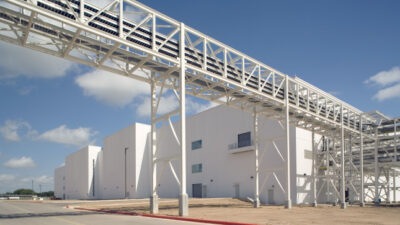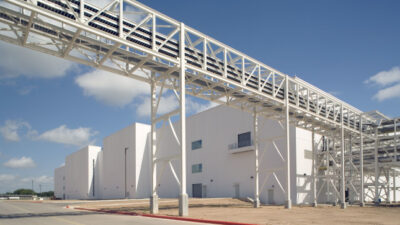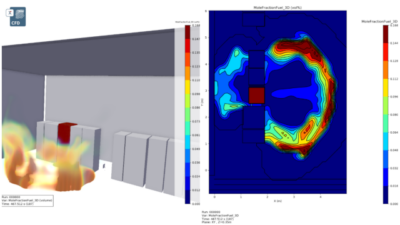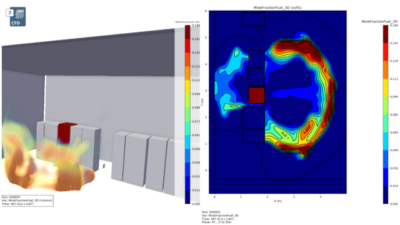At the intersection of energy codes, technology developments, cost constraints, and demands for higher efficiency and lower emissions, how should designers proceed?
CSE: With the construction market being down but the green market continuing to grow, please describe lighting-system trade-offs that engineers are dealing with.
Siva Haran: I think this recession has slowed down our efforts to continue designing state-of-the-art lighting systems and thwarted our ability to stay abreast of changing user attitudes and technological innovations in real-world applications. With banks limiting credit and consumers being extremely cautious about new purchases, even energy-efficient equipment has experienced a decline in usage. Belt-tightening consumers view the higher first cost pricing of such products as a deterrent.
Although stringent energy codes help ensure occupant safety and help the environment, they are sometimes barriers to good design. To keep costs down, at the same time meeting the energy codes, sometimes quality lighting is traded off. Some consulting engineers and energy service companies are looking for “low-hanging fruit” and doing lighting retrofits by just replacing lamps and ballasts, thereby reducing just the electrical energy. A relighting job using more efficient luminaires and controls will not only provide proper task performance and productivity but also provide higher energy savings.
Most schools, hospitals, and governmental buildings are owner occupied and seek to keep first costs down and get quick return on investment (ROI). We are putting sophisticated lighting control systems into the “add alternate” category. If the electrical bids come in low, which is possible in today’s business climate, controls can be bought within the budget.
Craig DiLouie: Green building practices, now entering the mainstream of commercial building construction, are creating new demands on lighting. But while this can present trade-offs for lighting design—where lighting systems are continually asked to do more for less—it is creating significant opportunities for lighting controls. For example, green construction encourages higher levels of control to save energy, incorporates daylight, and supports the ability for individuals and groups to control their own lighting.
Jeff Park: Lighting controls and lighting systems are even more important today than in past years. The green industry is being driven hard by building rating systems and by energy codes. Engineers have to react quickly to these requirements in a two-fold approach. Engineers have to provide systems designed to offer greater levels of control (controllability of systems) with increased levels of energy savings (energy and atmosphere), as required for higher point levels in green building rating systems such as [U.S. Green Building Council] LEED. But the tough part engineers are dealing with is project requirements and shrinking project budgets. An engineer who can design a solution that meets both of these requirements and design a cost-effective solution that provides actual savings is providing added value to its projects.
Jody Good: In some ways, the current economy allows more time for each project, which allows each design to be better on many levels. Some projects are trying to take advantage of an economy that is generating fewer overall projects by asking for cut fees, which is counterproductive, but it keeps architects, engineers, and designers busy, so we take the work. The avalanche of new greener products requires much more time in product evaluation and implementation on projects, so the diminished workload actually allows us to do this work more diligently.
CSE: Are lighting codes, standards, and regulations helping save energy, or are energy savings coming chiefly from better lighting technologies and design decisions?
Park: Energy codes and standards, such as ASHRAE Standard 90.1 , are helping to increase energy savings by requiring a minimum design level for commercial buildings and building systems that reduces the energy consumption in commercial buildings. Section 9 in ASHRAE Standard 90.1 has been increasing its scope by requiring mandatory lighting control requirements and basic sequences of operation for more space types and in more applications. When occupancy sensors were first required by energy codes, their sequence of operation was automatic ON and automatic OFF. Now with codes requiring greater levels of energy savings and additional sequence of operations, they provide greater levels of energy savings.
Good: Many owners are driven by LEED; others are still following the “lowest first cost” mantra. LEED helps justify or explain that there are better energy-effective design solutions and product selections, but the adoption and enforcement of energy and lighting codes are still necessary to drive the majority of project decisions. Many owners or architects are passionate about the best energy-effective solutions and they insist on studied, efficient designs and product selections. They are a pleasure to work with. But if it were not for the ever-stringent energy and lighting codes, we would be still using lowest first cost hardware and fewer occupancy and daylight sensors.
DiLouie: Today’s energy codes and standards are raising the bar on energy efficiency, harnessing efficient design and technology to minimize energy consumption in new buildings. The risk now is that energy codes are becoming so restrictive they will outpace the ability of technology to satisfy new demands for energy savings, and thereby begin to restrict design flexibility even more than they already do. The solution will be for energy codes to begin to be energy- or kWh-based, instead of power- or kW-based, to look at how buildings use energy over time. This will favor the use of lighting controls above the already growing list that is already required.
Haran: There is no doubt that codes and standards help save energy, but one should be careful that it does not promote bad lighting in the name of energy economy. Fundamental lighting quality should not be jeopardized. Energy savings should come from integrating highly efficient design and technology, lighting best practices, and controls. Integrated office lighting system and Integrated classroom lighting system by the California Lighting Technology Center are good examples of how one can achieve higher energy savings from efficient lighting technologies.
Our present codes actually limit connected load and do not take into account load shedding by bi-level controls, dimming or occupancy sensing, nor hours of use. The building industry is slowly moving toward Zero-Net Energy or Carbon Neutrality, which is the goal of Architecture 2030 program , and future editions of codes are considering these technologies.
CSE: How well are architecture, electrical and natural lighting, and HVAC design being integrated in the field? What tips can you recommend for integration?
Good: It is much too late to integrate these systems in the field. Systematic decisions made months earlier that are strategically integrated allow building systems to operate synergistically. Integrated solutions cannot be added to a built room very often. Over the past decade, energy-code requirements and LEED standards have caused designers to think about and look for, suggest, and use integrated design approaches. My home state (Utah) had a program that paid a bonus design fee to integrate energy-saving building systems, which led to better designs at modestly increased construction costs.
On Oct. 5, 2009, the President signed Executive Order (EO) 13514 calling for integrated design and building to benefit sustainability. The federal government is recognizing, in federally-owned or managed facilities, the need to mandate integrated design followed by integrated construction.
Haran: MEP engineers need to step up and take a more active role in the overall building process, especially at the early stages of the design process. Also, sustainable design and the drive for low-energy buildings have encouraged many owners and designers to include MEP engineers early in the design decisions. The reason is that these decisions have significant downstream effects in first cost, lifecycle cost, sustainability, and occupant safety, health, and comfort.
With 36% of all energy in the United States used by commercial and residential buildings, and with HVAC and lighting systems in a typical office using some 68% of the building energy, it is obvious that MEP engineers can have influence over a substantial portion of the nation’s energy use.
Early communication can be invaluable in the discussion surrounding building envelope and facades. A great deal of analysis by the MEP team is necessary to ensure that the building envelope is consistent with higher-performance buildings as defined by local energy codes. This is true with the recent architectural emphasis on large quantities of glazing. There is tension in the design process between sunlight and thermal comfort in heavily glazed buildings.
Park: Buildings are being designed with integrated systems; however, with project budgets being cut, value engineering can have an adverse effect on integrated systems. This may be particularly true if the systems are not revisited by the engineers to make sure the “value system” is not going to ruin the integrity of the initial integrated design. For instance, some green buildings have been in the news as underperforming on their design energy consumption goals. If systems are installed and not followed up with (i.e., functionally tested after installation, commissioned, or recommissioned after an initial period of time), there is no guarantee the integrated systems will perform as designed.
CSE: With new lighting controls for dimming, scheduling, status monitoring, shade controls, etc., how is long-term performance being addressed by designers?
Haran: Many studies have shown that with proper lighting and controls, there is tremendous improvement in performance, attitude, motivation, and attendance in workplaces and schools. Besides flexibility and control, digital systems offer energy code compliance, operating cost savings, and worker satisfaction. Wireless controls eliminate conduit and wire, saving overall electrical construction costs. Because some of these low voltage systems are highly customizable, there is potential for miscommunication. Commissioning is the only way to ensure that such a system works properly.
Good: We can “design in” the best, most advanced devices, lighting controls, etc., but we need to be certain the actual occupants (as opposed to the owners or their delegates who participated in the design meetings) are aware of the feature and are educated on how to operate them. We would try to explain this during our inspection trips, and we called for training in the specifications, but this proved insufficient. The advent of building commissioning, inside and outside of LEED, and the formalization of basis-of-design narratives has greatly helped this task.
CSE: What changes—additions, updates, or revisions—would you make to the Lighting Compliance section of ASHRAE 90.1?
Park: The Dept. of Energy (DOE) is pushing building energy codes and standards to reduce energy use in buildings by at least 30% over previous versions—ASHRAE Standard 90.1-2010 needs to show a reduction in building energy usage of at least 30%, below the 2004 standard.
With that said, ASHRAE standard is on its way to include automatic control of receptacles—this addendum has just passed through the second public review period ending Dec. 6, 2009. Automatic control of receptacles has the potential to provide buildings with an increase in energy savings that has not been targeted in earlier versions of the standard. ASHRAE Standard 90.1 also is implementing new control requirements, which include sequences of operation to ensure code-maximum energy savings with lighting controls above the automatic ON/automatic OFF requirements.
Good: Energy codes restrict maximum connected load without realizing the effect of controls on energy consumption. There are situations where we need to add lighting for a particular reason, and we strictly control its use to actual time required, yet the lighting power density (LPD) restrictions assume it will be on all the time, so we cannot use the lighting at all. Some of these situations can be very counterproductive. We could put a service light in a copy room for the occasional 30 foot-candles when needed with occupancy sensor or inconvenient switch to discourage normal use and light the room to 5 or 10 foot-candles for normal occupancy. Because we can’t do this due to the energy codes, we light the entire room to 30 foot-candles and waste energy.
In an office that uses daylight, I prefer to use a photocell-controlled fluorescent-dimming ballast. Since the LPD is calculated on nameplate wattages, if I want to use a photocell/dimming ballast and combination (with smooth daylight harvesting performance), I have to allow 70 W for this two-lamp luminaire. If I use a 60 W nondimming ballast, the same lamps operate at 44 W. Assuming the daylight control and building allow the full benefit of daylight technology, I cannot use the more passive and attractive solutions because I cannot afford the added 13 W/lamp.
DiLouie: Energy codes might benefit from focusing more on building operation, not just their design. This would include an emphasis on energy instead of power, lighting control commissioning, coverage of existing buildings instead of just new buildings, and requirements for designers to turn over a recommended maintenance policy to the owner.
Haran: To continue using the metric of LPD in W/sq ft, instead of energy usage density, in W hr/sq ft, doesn’t make sense. It puts the burden of proof for energy conservation on the designer, while W hr/sq ft places the responsibility for conservation on the owner, where it belongs.
Second, the quality of the visual environment should be recognized, evaluated, and incorporated into energy codes and standards. A consortium of lighting organizations such as Illuminating Engineering Society (IES), American Lighting Assn ., and Int’l Assn. of Lighting Designers (IALD) are collaborating with other organizations and agencies with the hopes of drafting a Memorandum of Understanding designed to develop a lighting quality criteria. This will be included in the energy conservation codes, standards, and certification programs.
CSE: What types of lighting retrofits are you seeing gain market share these days? Controls? Luminaires? Daylighting?
Good: Fifteen years ago, the retrofit business was rapidly expanding. This was due to the common dimensions of the T8 lamp and the simplicity of a lamp-ballast swap. Most of these opportunities are completed, or the owner is not interested. Retrofits today mostly involve changing luminaires. This can be effective, but it is more expensive and more disruptive to occupants. These are being done, but at a slower rate. Few owners are adding occupancy sensors or other control devices. Control systems are being serviced and replaced as they fail, but the advantages of adding them are not occurring to building operators like the T12/T8 lamp swap was. Building codes affecting renovations and utility and tax rebates are supporting this effort, but generally retrofits are diminished overall, perhaps as a factor of today’s economy, too.
Haran: Because of the mandatory energy codes, the use of automatic controls, occupancy sensors, and time-based controls is increasing. A majority of lighting retrofits include replacing incandescent with compact fluorescent lamps (CFL) and replacing T12 magnetic with T8 electronic.
The General Services Admin. was allocated $5.5 billion as part of the American Recovery and Reinvestment Act, of which $2 billion will be allocated to create jobs and pioneer cutting-edge technology, which includes integrated daylighting systems.
DiLouie: The most significant emerging lighting control technology trends include digital communication architecture, wireless control, self-configuring/commissioning controls, fixture-integrated controls, daylight harvesting, and LED controls. In existing buildings, lighting controls should be incorporated into lamp and ballast retrofits as well as major renovations.
CSE: What are some cost-effective lighting system best practices that engineers can design/specify to help owners save money right away?
Good: The simplest design effort actually can be to design the lighting and the control for each space, and not apply last year’s solution. The availability of several ballast factors for linear fluorescent lamps and the new increased and reduced light output (and wattage) lamps allow many new options for consideration.
The same can be said about compact fluorescent lamps. LEDs are changing monthly and require foresight, anticipation, and faith. These are truly changing times where we earn our money for correct advice.
Haran: The following are some best practices we should be incorporating to help conserve energy:
-
Replace incandescents with CFLs.
-
Replace all T12 lamps, magnetic ballasts, and deep-cell parabolic-louvered troffers.
-
Use bi-level lighting with occupancy sensors in stairways and corridors.
-
In industrial spaces with high ceilings, T8 or T5 and T5HO will save energy when replacing high-intensity discharge (HID) bulbs.
-
There’s good chance that parking lot lighting load can be reduced with LED units.
-
Direct/indirect continuous pendant units are preferred for classrooms, with occupancy (or vacancy) sensors a must and daylight harvesting a good possibility.
-
For retail stores open 24/7 with front windows, bi-level lighting controlled by timers or daylight sensors is an effective energy saver.
-
You can also save energy by reducing the IESNA Handbook-recommended illuminance levels by improving the task contrast and size, which improves the viewer’s visual performance.
CSE: What’s your best design tip for energy-efficient, high-quality lighting solutions?
Good: Successful projects come from integration of lighting and architecture, especially influencing ceiling heights and lighting mounting opportunities; using daylighting where sensible; providing the maximum control equipment; and selecting the best and most current lighting hardware.
Park: The best advice I would give for a successful energy-efficiency project is to know what your energy goals are and know what the cost is for the amount of savings you are expecting.
Participants
Craig DiLouie
Education Director, Lighting Controls Assn. Rosslyn, Va.
Joseph M. “Jody” Good , III LC, LEED AP
Principal Lighting and Theatre Designer, Spectrum Engineers Inc. Salt Lake City
Siva Haran , PE, LC, LEED AP
Electrical Lighting Consultant, Chicago
Jeff Park
Sustainable Market Development Manager, WattStopper Birmingham, Ala.



